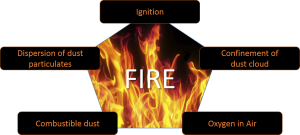HAFCOVAC provides a comprehensive dust control solution for combustible materials.
 More than 450 accidents involving combustible dust have killed nearly 130 workers and injured another 800-plus since 1980, according to a Center for Public Integrity analysis of data compiled by the federal Occupational Safety and Health Administration and the U.S. Chemical Safety Board. These fires and explosions havebeen caused by a variety of dust sources including sugar, nylon fiber, coal, iron, plastic and wood.Most in the manufacturing industry are aware of some of the dangers and have read or seen reports of these explosions in the news.
More than 450 accidents involving combustible dust have killed nearly 130 workers and injured another 800-plus since 1980, according to a Center for Public Integrity analysis of data compiled by the federal Occupational Safety and Health Administration and the U.S. Chemical Safety Board. These fires and explosions havebeen caused by a variety of dust sources including sugar, nylon fiber, coal, iron, plastic and wood.Most in the manufacturing industry are aware of some of the dangers and have read or seen reports of these explosions in the news.
An explosion ripped through the New Cumberland A.L. Solutions titanium plant in West Virginia on December 9, 2010, fatally injuring three workers. The plant workers were processing titanium powder at the time of the explosion. The AL Solutions incident is one of nine serious combustible dust incidents investigated by the CSB since 2003, including the Imperial Sugar disaster near Savannah, Georgia, in 2008 as well as three combustible dust incidents over a six month period in 2011 at the Hoeganaes facility located in Gallatin, TN. These nine explosions and fires caused a total of 36 deaths and 128 injuries.
Dust and other debris will always be present in the manufacturing process. Since dust is inevitable in the process, manufacturing facilities must take the proper measures to understand the risks, learn as much as possible about the threat and take solid measures to prevent potential hazards and be prepared should an incident take place.
We hope this Introduction to Combustible dust is a first step in learning more and taking ad-equate measures to reduce risks. We encourage you to lean more and seek additional information from the resources listed at the back of this guide.
Whitepaper Download